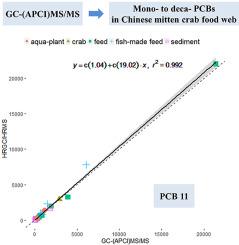Chemosphere ( IF 8.8 ) Pub Date : 2020-11-23 , DOI: 10.1016/j.chemosphere.2020.129055 Xiaomin Li , Yunpeng Zhen , Ruiguo Wang , Tong Li , Shujun Dong , Wei Zhang , Jie Cheng , Peilong Wang , Xiaoou Su

|
Polychlorinated biphenyls (PCBs) and dibenzo-p-dioxins and furans (PCDD/Fs) are notorious persistent organic pollutants (POPs), which may bioaccumulate through food chain and play detrimental effects to organisms even at trace levels. Quantification of PCBs and PCDD/Fs in biotic samples is a great challenge. In the present study, gas chromatography coupled to triple quadrupole mass spectrometry with an atmospheric pressure chemical ionization source (GC-(APCI)MS/MS) was studied for the isotope-dilution analysis of PCBs (mono-to deca-) and PCDD/Fs in Chinese mitten crab food webs. High-resolution mass spectrometry (HRMS) was applied for comparison. Low-weight PCBs are compared between the two instruments for the first time. After optimization of instrument parameters, the RSDs of relative response factors of calibration curves were between 3.4%-15.5% for PCBs and 1.7%-7.9% for PCDD/Fs. The limits of detection were between 0.021-0.150 pg/mL for PCBs and 0.051-0.237 pg/mL for PCDD/Fs. PCB concentrations in crab food web samples detected by GC-(APCI)MS/MS were well correlated with those detected by HRGC/HRMS. A DiCB, 3,3’-dichlorobiphenyl (PCB11), was identified as the dominant PCB congener in aquatic food webs. Other MoCB and DiCB congeners were also widely identified; hence, low-weight PCB congeners should arouse more concern in the future. GC-(APCI)MS/MS may become an alternative instrument for satisfying the requirements of PCB and PCDD/F detection.
中文翻译:

气相色谱-三重四极杆质谱联用(GC-(APCI)MS / MS)在中华绒螯蟹食物网中多氯联苯(单至十碳)和多氯二苯并对二恶英的测定中的应用
多氯联苯(PCBs)和二苯并p-二恶英和呋喃(PCDD / Fs)是臭名昭著的持久性有机污染物(POPs),它们可能通过食物链进行生物蓄积,甚至对微量生物也有不利影响。生物样品中PCBs和PCDD / Fs的定量分析是一个巨大的挑战。在本研究中,研究了采用常压化学电离源(GC-(APCI)MS / MS)结合三重四极杆质谱联用气相色谱法对PCBs(单-十-)和PCDD /进行同位素稀释分析的方法。 Fs在中华绒螯蟹食物网中。高分辨率质谱(HRMS)用于比较。首次比较了两种仪器之间的低重量PCB。优化仪器参数后,PCB的校准曲线相对响应因子的RSD在3.4%-15.5%之间,而PCDD / Fs在1.7%-7.9%之间。多氯联苯的检出限为0.021-0.150 pg / mL,而PCDD / Fs的检出限为0.051-0.237 pg / mL。GC-(APCI)MS / MS检测蟹食物网样品中的PCB含量与HRGC / HRMS检测到的PCB浓度相关性很好。DiCB 3,3'-二氯联苯(PCB11)被确定为水生食物网中的主要PCB同类物。其他MoCB和DiCB同系物也得到了广泛认可;因此,低重量的PCB同类产品将在未来引起更多关注。GC-(APCI)MS / MS可能成为满足PCB和PCDD / F检测要求的替代仪器。被确定为水生食品网中的主要多氯联苯同类物。其他MoCB和DiCB同系物也得到了广泛认可;因此,低重量的PCB同类产品将在未来引起更多关注。GC-(APCI)MS / MS可能成为满足PCB和PCDD / F检测要求的替代仪器。被确定为水生食品网中的主要多氯联苯同类物。其他MoCB和DiCB同系物也得到了广泛认可;因此,低重量的PCB同类产品将在未来引起更多关注。GC-(APCI)MS / MS可能成为满足PCB和PCDD / F检测要求的替代仪器。


























 京公网安备 11010802027423号
京公网安备 11010802027423号